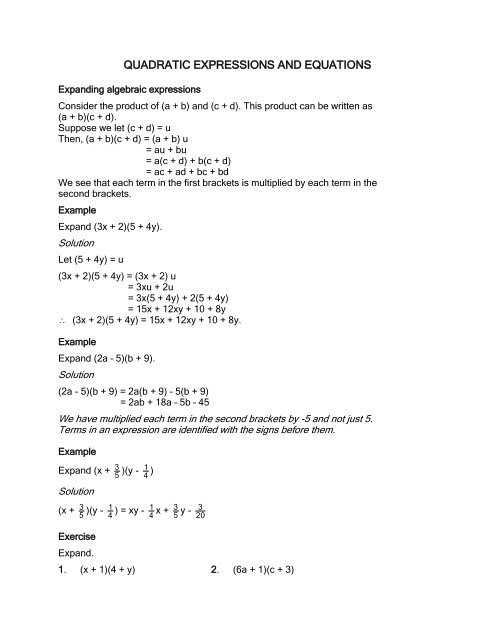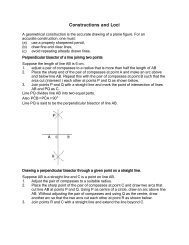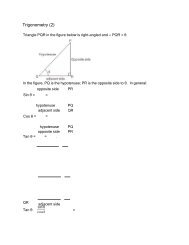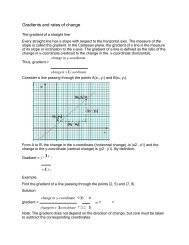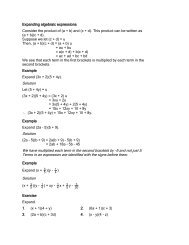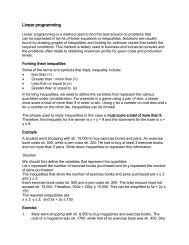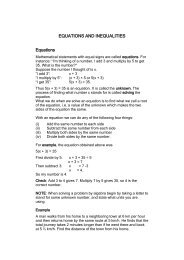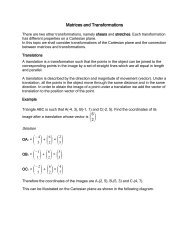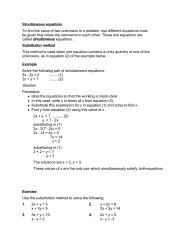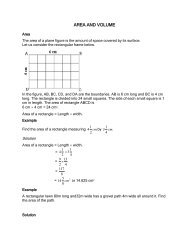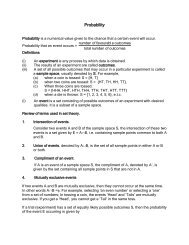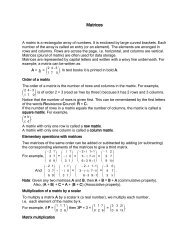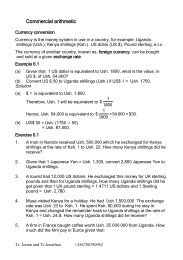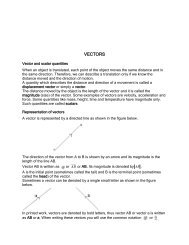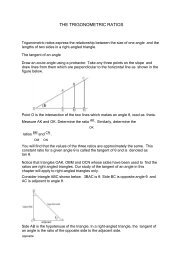J17
You also want an ePaper? Increase the reach of your titles
YUMPU automatically turns print PDFs into web optimized ePapers that Google loves.
QUADRATIC EXPRESSIONS AND EQUATIONS<br />
Expanding algebraic expressions<br />
Consider the product of (a + b) and (c + d). This product can be written as<br />
(a + b)(c + d).<br />
Suppose we let (c + d) = u<br />
Then, (a + b)(c + d) = (a + b) u<br />
= au + bu<br />
= a(c + d) + b(c + d)<br />
= ac + ad + bc + bd<br />
We see that each term in the first brackets is multiplied by each term in the<br />
second brackets.<br />
Example<br />
Expand (3x + 2)(5 + 4y).<br />
Solution<br />
Let (5 + 4y) = u<br />
(3x + 2)(5 + 4y) = (3x + 2) u<br />
= 3xu + 2u<br />
= 3x(5 + 4y) + 2(5 + 4y)<br />
= 15x + 12xy + 10 + 8y<br />
(3x + 2)(5 + 4y) = 15x + 12xy + 10 + 8y.<br />
Example<br />
Expand (2a – 5)(b + 9).<br />
Solution<br />
(2a - 5)(b + 9) = 2a(b + 9) – 5(b + 9)<br />
= 2ab + 18a – 5b – 45<br />
We have multiplied each term in the second brackets by -5 and not just 5.<br />
Terms in an expression are identified with the signs before them.<br />
Example<br />
Expand (x + 5 3 )(y - 4 1 )<br />
Solution<br />
(x + 3 5<br />
)(y - 1 4<br />
) = xy - 1 4<br />
x + 3 5<br />
y -<br />
3<br />
20<br />
Exercise<br />
Expand.<br />
1. (x + 1)(4 + y) 2. (6a + 1)(c + 3)
3. (2a + b)(c + 3d) 4. (x - y)(4 - z)<br />
5. (a – 3d)(4c - b) 6. (8x + y)(a + 1)<br />
7. (2u - v)(3x - y) 8. (p + q)(s - t)<br />
9. (x + y)(c - 5) 10. (x + 1)(y - 1)<br />
11. (x + 2 1 )(y + 4<br />
1<br />
) 12. (u + w)(a + 2)<br />
13. (5a + 4)(b - 3) 14. (x + y)(<br />
1 a - c)<br />
2<br />
Consider the product of (x + 3)(x + 4).<br />
(x + 3)(x + 4) = x(x + 4) + 3(x + 4)<br />
= x 2 + 4x + 3x + 12<br />
= x 2 + 7x + 12<br />
Quadratic expressions<br />
This kind of an expression where the highest power is 2 is called a quadratic<br />
expression. Most quadratic expressions have three distinct terms known as<br />
the quadratic term (x 2 ), the linear term (7x) and the number term or constant<br />
term (12).<br />
A quadratic expression must have the quadratic term which should also be<br />
the term with the highest power of the unknown letter. For example,<br />
x 2 + 3x + 1, a 2 + 2a, y 2 – 2y + 1, c 2 – 4, e.t.c. but x 3 – 2x, 2x 3 – x 2 + 6, 4x +8<br />
are not.<br />
Example<br />
Expand and simplify:<br />
(a) (2x + 1)(x + 3) (b) (x – 5)(x – 2),<br />
(c) (2a – 3)(5a – 4).<br />
Solutions<br />
(a) (2x + 1)(x + 3) = 2x(x + 3) + 1(x + 3)<br />
= 2x 2 + 6x + x + 3<br />
= 2x 2 + 7x + 3<br />
(b) (x – 5)(x – 2) = x(x – 2) – 5(x – 2)<br />
= x 2 – 2x – 5x + 10<br />
= x 2 – 7x + 10<br />
(c) (2a - 3)(5a – 4) = 2a(5a – 4) – 3(5a – 4)<br />
= 10a 2 – 8a – 15a + 12<br />
= 10a 2 – 23a + 12<br />
Exercise<br />
Expand and simplify.
1. (x + 3)(x + 1) 2. (x + 2)(x – 4)<br />
3. (x – 7)(x + 3) 4. (x – 4)(x – 3)<br />
5. (a + 8)(a – 3) 6. (p + 2)(p – 5)<br />
7. (x – 5)(x + 4) 8. (x + 5)(x + 4)<br />
9. (x + 2)(5x + 3) 10. (3x + 2)(x – 4)<br />
11. (2x – 7)(4x – 3) 12. (x +3)(x + 3)<br />
13. (a – 4)(a – 4) 14. (x + 7)(x – 7)<br />
15. (5t + 3)(3t + 2) 16. (2 – x)(3 – x)<br />
17. (3 + p)(5 – p) 18. (4 – 2y)(1 – 3y)<br />
19. (3x + 1)(8 – 2x) 20. (5 – 3x)(2 – 4x)<br />
The quadratic identities<br />
1. Show that (a + b)(a + b) = a 2 + 2ab + b 2 .<br />
The product (a + b)(a + b) can be written as (a + b) 2 . Thus,<br />
(a + b) 2 = (a + b)(a + b)<br />
= a 2 + ab + ab + b 2<br />
= a 2 + 2ab + b 2<br />
This product is illustrated in the figure below.<br />
Consider a square with side (a + b) units. The square is divided into:<br />
(a) square A of side a,<br />
(b) square D of side b,<br />
(c) rectangle B of sides a and b,<br />
(d) rectangle C of sides a and b.<br />
Area of the big square = (a + b) 2<br />
Area of: square A = a 2<br />
rectangle B = ab<br />
rectangle C = ab<br />
square D = b 2<br />
Rectangles B and C are identical.<br />
The area of A + B + C + D = a 2 + ab + ab + b 2<br />
Therefore, (a + b) 2 = a 2 + ab + ab + b 2<br />
= a 2 + 2ab + b 2
2. Show that (a – b)(a – b) = a 2 – 2ab + b 2<br />
Consider a square of side a units. The square can be divided into two squares: one of<br />
side (a – b) and another of side b; and two identical rectangles of side b and (a – b). That<br />
is:<br />
(a) square A has sides (a – b),<br />
(b) rectangles B and C have sides b by (a – b),<br />
(c) square D has side b.<br />
Area of the big square = a 2 ………………………(i)<br />
Area of square A = (a – b)(a – b)<br />
= (a – b) 2<br />
Area of rectangle B = (a – b)b<br />
= ab - b 2<br />
Area of rectangle C<br />
= (a – b)b<br />
= ab – b 2<br />
Area of square D = b 2<br />
Total area = (a – b) 2 + ab – b 2 + ab – b 2 + b 2<br />
= (a – b) 2 + 2ab – b 2 ……………….(ii)<br />
Equating (i) and (ii) gives:<br />
(a – b) 2 + 2ab – b 2 = a 2<br />
Therefore, (a – b) 2 = a 2 – 2ab + b 2 .<br />
Note: (a + b) 2 ≠ a 2 + b 2 and (a – b) 2 ≠ a 2 – b 2<br />
3. Show that (a + b)(a – b) = a 2 – b 2<br />
Consider a square of side a units. See figure below.<br />
The square is divided into:<br />
(a) square A of side b,<br />
(b) square D of side (a – b),<br />
(c) rectangles B and C of sides b by a – b.<br />
Area of the big square = a 2 ………………………(i)
Area of square A = b 2<br />
Area of rectangle B = (a – b)b<br />
Area of rectangle C = (a – b)b<br />
Area of square D = (a – b) 2<br />
Total area = (a – b)b + (a – b)b + (a – b) 2 + b 2<br />
= 2(a – b)b + (a – b) 2 + b 2 ……….(ii)<br />
Equating (i) and (ii) gives:<br />
2(a – b)b + (a – b) 2 + b 2 = a 2<br />
Therefore, 2b(a – b) + (a – b) 2 = a 2 – b 2<br />
This means, (a – b)[2b + (a – b)] = a 2 – b 2 , a – b is common.<br />
That is, (a – b)(2b + a – b) = a 2 – b 2 ,<br />
Therefore, (a + b)(a – b) = a 2 – b 2<br />
Expanding, (a + b)(a – b) = a(a – b) + b(a – b)<br />
= a 2 – ab + ab – b 2<br />
= a 2 – b 2<br />
The expression, (a + b)(a – b), is called the difference of two squares.<br />
The three important identities can thus be summarized as:<br />
(a) (a + b) 2 = a 2 + 2ab + b 2<br />
(b) (a – b) 2 = a 2 – 2ab + b 2<br />
(c) (a + b)(a – b) = a 2 – b 2<br />
Example<br />
Expand and simplify:<br />
(a) (x + 4) 2 (b) (x – 5) 2<br />
(c) (x + 3)(x – 3) (d) (2x + 1) 2<br />
(e) (3x + 2)((3x – 2)<br />
Solutions<br />
(a) (x + 4) 2 = (x + 4)(x + 4)<br />
= x(x + 4) + 4(x + 4)<br />
= x 2 + 4x + 4x + 16<br />
= x 2 + 8x + 16<br />
(b) (x – 5) 2 = (x – 5)(x – 5)<br />
= x(x – 5) – 5(x – 5)<br />
= x 2 – 5x – 5x + 25<br />
= x 2 – 10x + 25<br />
(c) (x + 3)(x – 3) = x(x – 3) + 3(x – 3)<br />
= x 2 – 3x + 3x -9<br />
= x 2 – 9<br />
Note: (x 2 – 9 = x 2 – 3 2 )<br />
(d) (2x + 1) 2 = (2x + 1)(2x + 1)<br />
= 2x(2x + 1) + 1(2x + 1)<br />
= 4x 2 + 2x + 2x + 1<br />
= 4x 2 + 4x + 1
(e) (3x + 2)(3x – 2) = 3x(3x – 2) + 2(3x – 2)<br />
= 9x 2 – 6x + 6x – 4<br />
= 9x 2 – 4<br />
Note: 9x 2 – 4 = (3x) 2 – 2 2 .<br />
Exercise : Expand.<br />
1. (x + 1) 2 2. (x + 2) 2<br />
3. (a – 5) 2 4. (p + q) 2<br />
5. (a + 6) 2 6. (b – 8) 2<br />
7. (x – y) 2 8. (x + 1)(x – 1)<br />
9. (y – 9)(y + 9) 10. (y – x)(y + x)<br />
11. (y – a)(y + a) 12. (3x + 4) 2<br />
13. (2a – 7)(2a + 7) 14. (5x + 3) 2<br />
15. (4x – 1) 2 16. (7a – 3) 2<br />
17. (2x – 1) 2 18. (3 – 2x) 2<br />
19. (c – ax) 2 20. (x – 1) 2<br />
21. u 1 2<br />
22. a 3<br />
2<br />
4<br />
23. 2x 1 2<br />
24. 1 x 3 2<br />
3<br />
2<br />
4<br />
Factorizing expressions<br />
If the product of 5 and 7 is 35, then 5 and 7 are factors of 35.<br />
In algebra, letters represent numbers. Therefore, we can extend the idea of factors to<br />
algebraic expressions. For example, a and b are factors of ab and 2, x and y are factors<br />
of 2xy. Also, given that 5(a – b) = 5a – 5b, then, 5 and (a – b) are factors of 5a – 5b.<br />
In order to find the factors of an expression such as 10x 2 + 15x, we look for the factors<br />
that are common in both terms. The common factors of 10x 2 and 15x are 5 and x.<br />
Thus, 10x 2 + 15x = (5x × 2x) + (5x × 3)<br />
= 5x(2x + 3).<br />
Therefore, the factors of 10x 2 + 15x are 5, x and (2x + 3). This means,<br />
10x 2 + 15x can be factorized as 5x(2x + 3).<br />
The process of finding the factors of an expression is called factorization. This is the<br />
reverse of expansion.<br />
Consider (x + 2)(x + 3) = x(x + 3) + 2(x +3)<br />
= x 2 + 3x + 2x + 6<br />
= x 2 + 5x + 6.<br />
The expressions (x + 2) and (x + 3) are the factors of x 2 + 5x + 6.
Similarly:<br />
(a) (x + 3)(x + 4) = x(x + 4) + 3(x + 4)<br />
= x 2 + 4x + 3x + 12<br />
= x 2 + 7x + 12.<br />
(b) (x + 2)(x + 7) = x(x + 7) + 2(x + 7)<br />
= x 2 + 7x + 2x + 14<br />
= x 2 + 9x + 14<br />
(c) (x + a)(x + b) = x(x + b) + a(x + b)<br />
= x 2 + bx + ax + ab<br />
= x 2 + (a + b)x + ab<br />
The last expression shows the relationship between the terms of the quadratic<br />
expression and its factors. Thus, a constant term ab of a quadratic expression is the<br />
product of the number terms a and b. whereas, the coefficient of x is the sum of a and b.<br />
Example<br />
Factorize x 2 + 10x + 21.<br />
Solution<br />
Compare x 2 + 10x + 21 and (x + __)(x + __), considering<br />
x 2 + (a + b)x + ab = (x + a)(x + b).<br />
This means x 2 + 10x + 21 = x 2 + (a + b)x + ab.<br />
We need two numbers a and b such that a + b = 10 and ab = 21<br />
Clearly, a and b are factors of 21 whose sum is 10. These are 3 and 7.<br />
Rewriting x 2 + 10x + 21 as x 2 + (3 + 7)x + 21 gives x 2 + 3x + 7x + 21<br />
= x(x + 3) + 7(x + 3)<br />
= (x + 3)(x + 7).<br />
Therefore, x 2 + 10x + 21 = (x + 3)(x + 7).<br />
Example<br />
Factorize x 2 + 7x + 12.<br />
Solution<br />
We need two numbers a and b such that a + b = 7 and ab = 12. These numbers are 3<br />
and 4.<br />
Thus, x 2 + 7x + 12 = x 2 + (3 + 4)x + 12<br />
= x 2 + 3x + 4x + 12<br />
= x(x + 3) + 4(x + 3)<br />
= (x + 3)(x + 4)<br />
Example<br />
Factorize x2 – 6x + 8<br />
Solution
Let, x 2 – 6x + 8 = (x + a)(x + b).<br />
Thus. X 2 – 6x + 8 = x 2 + (a + b) + ab.<br />
Then, (a + b) = -6 and ab = 8<br />
Two numbers which add up to -6 and whose product is 8 are -2 and -4.<br />
So, x 2 – 6x + 8 = x 2 + (-2 + -4)x + 8<br />
= x 2 – 2x – 4x + 8<br />
= x(x – 2) – 4(x – 2)<br />
= (x – 2)(x – 4).<br />
Example<br />
Factorize x 2 – x – 30<br />
Solution<br />
Remember that x 2 – x – 30 = x 2 – 1x – 30<br />
Let x 2 - x – 30 = (x + a)(x + b)<br />
= x 2 + (a + b)x + ab.<br />
Thus, (a + b) = -1 and ab = -30. 5 and -6 satisfy both of these equations.<br />
So, x 2 – x – 30 = (x + 5)(x – 6)<br />
Example<br />
Factorize x 2 + 3x – 28.<br />
Solution<br />
Let x 2 + 3x – 28 = (x + a)(x + b) = x 2 + (a + b)x + ab<br />
Thus, (a + b) = 3 and ab = -28.<br />
The factors of -28 whose sum is 3, are 7 and -4.<br />
So, x 2 + 3x – 28 = (x + 7)(x – 4)<br />
Example<br />
Factorize:<br />
(a) x 2 + 12x + 36 (b) x 2 – 8x + 16<br />
Solutions<br />
(a)<br />
Let x 2 + 12x + 36 = (x + p)(x + q) = x 2 + (p + q)x + pq<br />
Thus, p + q = 12 and pq = 36.<br />
The factors of 36 whose sum is 12, are 6 and 6.<br />
So, x 2 + 12x + 36 = (x + 6)(x + 6) = (x + 6) 2<br />
(b) Let, x 2 – 8x + 16 = (x + p)(x + q) = x 2 + (p + q)x + pq<br />
Thus, p + q = -8 and pq = 16<br />
The factors of 16 whose sum is -8, are -4 and -4.<br />
So, x 2 – 8x + 16 = (x – 4)(x – 4) = (x – 4) 2<br />
Note: x 2 + 16x + 36 and x 2 – 8x + 16 are perfect squares because their factors are<br />
identical.
Exercise<br />
Factorize:<br />
1. x 2 + 7x + 10 2. x 2 + 13x + 42<br />
3. x 2 + 9x + 14 4. x 2 + 2x – 15<br />
5. x 2 + x – 12 6. p 2 – 10p + 12<br />
7. a 2 – 2a – 35 8. d 2 + 5d – 36<br />
9. v 2 – 14v + 45 10. u 2 – u – 56<br />
11. x 2 + 9x + 8 12. n 2 – 10n + 25<br />
13. x 2 – 2x + 1 14. c 2 – c – 2<br />
15. y 2 + 14y + 24 16. w 2 + 5w – 6<br />
17. 9 – 6r + r 2 18. 49 + 14t + t 2<br />
19. 4 + 4k + k 2 20. x 2 + 11x – 26<br />
The difference of two squares<br />
Earlier in this chapter, we learnt that (a + b)(a – b) = a 2 – b 2 . Thus, the difference of the<br />
squares of two numbers is equal to the product of their sum and their difference. The<br />
factors of a 2 – b 2 are (a + b) and (a – b).<br />
In order to factorize the difference of two squares, it is important to rewrite the<br />
expression so that the squares are clearly seen. For example:<br />
(a) a 2 – 9b 2 = a 2 – (3b) 2<br />
= (a – 3b)(a + 3b),<br />
(b) 1 – 16x 2 = 1 2 – (4x) 2<br />
= (1 + 4x)(1 – 4x),<br />
(c) 4x 2 – 25y 2 = (2x) 2 – (5y) 2<br />
= (2x + 5y)(2x – 5y).<br />
However, some expressions which involve the difference of squares require us to find<br />
the common factors first.<br />
Example<br />
Factorize:<br />
(a) 7x 2 – 7y 2 (b) 3x 2 – 75y 2<br />
Solutions<br />
(a)<br />
(b)<br />
Both terms have a common factor, 7. Therefore factorize as follows:<br />
7x 2 – 7y 2 = 7(x 2 – y 2 )<br />
= 7(x + y(x – y)<br />
3 is a common factor in the two terms.<br />
Thus, 3x 2 – 75y 2 = 3(x 2 – 25y 2 )<br />
= 3[x 2 – (5y) 2 ]
= 3(x + 5y)(x – 5y)<br />
The difference of two squares can be used to evaluate some expressions that involve<br />
numbers in a faster way.<br />
Example<br />
Evaluate:<br />
(a) 99 2 – 1 (b) 8.49 2 – 1.51 2<br />
(c) 1012 × 988<br />
Solutions<br />
(a) 99 2 – 1 = 99 2 - 1 2<br />
= (99 – 1)(99 + 1)<br />
= 98 × 100<br />
= 9800<br />
(b) 8.49 2 – 1.51 2 = (8.49 – 1.51)(8.49 + 1.51)<br />
= 6.98 × 10<br />
= 69.8<br />
(c) 1,012 × 988 = (1,000 + 12)(1,000 – 12)<br />
= 1,000 2 – 12 2<br />
= 1,000,000 – 144<br />
= 999,856<br />
Exercise<br />
1. Factorize:<br />
(a) x 2 – 2 2 (b) x 2 – 5 2<br />
(c) 7 2 – n 2 (d) 1 – t 2<br />
(e) (3a) 2 – 1 (f) 4c 2 – 25 2<br />
(g) 25 – 49r 2 (h) p 2 – 36q 2<br />
(i) p 2 q 2 – 1 (j) 48a 2 – 3t 2<br />
(k) 72m 2 – 2 (l) 4p 2 - 4q 2<br />
(m) x 4 – 1 (n) a 3 b – ab 3<br />
(o) nu 2 – nv 2<br />
2. Calculate:<br />
(a) 78.3 2 – 21.7 2 (b) 923 2 – 77 2<br />
(c) 0.843 2 – 0.157 2 (d) 75 2 – 25 2
(e) 94 × 106 (f) 975 × 1,025<br />
(g) 3 × 25 2 – 3 × 75 2 (h) 5 × 12 2 – 5 × 88 2<br />
(i) 6 × 53 2 – 6 × 47 2 (j)<br />
22 2<br />
56 22 56<br />
3. Factorize completely<br />
(a) x 2 y 2 – 16 (b) 1 – p 2 q 2<br />
(c) 9x 2 – y 2 (d) a 2 b 2 – c 2<br />
(e) 3x 2 – 27 (f) 2a 2 – 8<br />
(g) 5a 2 b 2 – 45c 2 (h) 8a 2 – 32b 2 c 2<br />
(i) 100 – x 2 (j) 16x 2 – 25<br />
(k) 81 – x 2 y 2 (l) x 2 y 2 – p 2 q 2<br />
(m) 3x 2 – 48y 2 z 2 (n) 5b 2 c 2 – 20d 2 g 2<br />
Solving quadratic equations<br />
7<br />
We solve an equation by finding the value of the unknown. For any two numbers, p and<br />
q, if pq = 0, then, either:<br />
(a) p = 0 which means 0 × q = 0<br />
(b) q = 0 which means p × 0 = 0<br />
(c) p = q = 0 which means 0 × 0 = 0<br />
Similarly, if (x + 2)(x+ 3) = 0, then either x + 2 = 0 or x + 3 = 0.<br />
Solving for x, gives either x = -2 or x = -3.<br />
Thus, in order to solve a quadratic equation, the quadratic expression is factorized so<br />
that the equation is in the form (x + a)(x + b) = 0.<br />
Example<br />
Solve (x – 4)(x + 1) = 0<br />
7<br />
2<br />
Solution<br />
If (x – 4)(x + 1) = 0, then either x – 4 = 0 or x + 1 = 0.<br />
Therefore, x = 4 or x = -1.<br />
Hence the roots of the equation (x – 4)(x + 1) = 0 are 4 and -1.<br />
Example<br />
Factorize x 2 + 7x + 6 = 0<br />
Solution<br />
x 2 + 7x + 6 = 0<br />
Factorizing, x 2 +7x + 6, gives (x + 6)(x + 1) = 0.<br />
Therefore, x + 6 = 0 or x + 1 = 0; which means x = -6 or x = -1<br />
These are the only two values of x which satisfy the equation x 2 + 7x + 6 = 0. We can<br />
check these solutions by substituting each of them in the equation.
Thus, when x = -6,<br />
(-6) 2 + 7(-6) + 6 = 36 – 42 + 6 = 0<br />
And when x = -1<br />
(-1) 2 + 7(-1) + 6 = 1 – 7 + 6 = 0<br />
Note: Every quadratic equation has two solutions.<br />
Example<br />
Solve: x 2 + x – 72 = 0<br />
Solution<br />
x 2 + x – 72 = 0<br />
(x – 8)(x + 9) = 0. x – 8 = 0 or x + 9 = 0<br />
x = 8 or x = -9.<br />
Example<br />
Solve: x 2 – x – 29 = 1<br />
Solution<br />
Always ensure that the quadratic expression is equated to zero. This is the only time the<br />
method used in the examples above can apply.<br />
Thus, x 2 – x – 29 = 1 should be rewritten as x 2 – x – 29 – 1 = 0. That is,<br />
x 2 – x – 30 = 0.<br />
The factors of 30, whose sum is 1, are -6 and 5.<br />
Therefore, (x – 6)(x + 5) = 0.<br />
Either x – 6 = 0 or x + 5 = 0<br />
x = 6 or x = -5<br />
The roots are -5 and 6.<br />
Example<br />
Solve:<br />
(a) x 2 – 49 = 0 (b) x 2 – 6x = 0<br />
(c) x 2 – 16x + 64 = 0 (d) 6x 2 + 5x – 4 = 0<br />
Solutions<br />
(a) x 2 – 49 = 0 can be written as x 2 – 7 2 = 0<br />
(x – 7)(x + 7) = 0<br />
x – 7 = 0 or x + 7 = 0 x = 7 or x = -7.<br />
The roots are -7 and 7.<br />
(b) Factorizing x 2 – 6x = 0 gives x(x – 6) = 0<br />
Either x = 0 or x – 6 = 0<br />
x = 0 or x = 6<br />
The roots are 0 and 6.<br />
(c) x 2 – 16x + 64 = 0
Factorizing x 2 – 16x + 64 = 0 gives (x – 8)(x – 8) = 0<br />
Either x – 8 = 0 or x – 8 = 0<br />
x = 8 or x = 8<br />
The roots are 8 and 8.<br />
Note: x 2 – 16x + 64 is a perfect square and therefore it has identical factors. The<br />
equation x 2 – 16x + 64 = 0 has two equal roots.<br />
(d) 6x 2 + 5x – 4 = 0<br />
When the coefficient of x 2 ,(in this case it is 6), in the quadratic expression is<br />
numerically greater than 1, we proceed as follows when factorizing:<br />
- Multiply the coefficient of x 2 by the constant term, i.e. 6 × -4 = -24.<br />
- Find the factors of -24 whose sum is 5, (the coefficient of x), i.e. -3 and 8.<br />
- Rewrite the equation as:<br />
6x 2 + (-3 + 8)x – 4 = 0<br />
6x 2 – 3x + 8x – 4 = 0<br />
3x(2x – 1) + 4(2x – 1) = 0<br />
(2x – 1)(3x + 4) = 0<br />
Then, either 2x – 1 = 0 or 3x + 4 = 0<br />
2x = 1 or 3x = -4<br />
x =<br />
1<br />
2<br />
or x = - 4 3<br />
.<br />
Example<br />
Factorize 3x 2 – 22x + 7. Hence solve 3x 2 – 22x + 7 = 0<br />
Solution<br />
3x 2 – 22x + 7<br />
Multiplying 3 by 7, gives 21. The factors of 21 whose sum is -22, are -1 and<br />
-21.<br />
Then, 3x 2 – 22x + 7 3x 2 + [-1 + (-21)]x + 7<br />
3x 2 – 1x – 21x + 7<br />
x(3x – 1) -7(3x – 1)<br />
(3x – 1)(x – 7)<br />
Hence, 3x 2 – 22x + 7 = (3x – 1)(x – 7).<br />
The equation 3x 2 – 22x + 7 = 0 can be written as (3x – 1)(x – 7) = 0<br />
Either 3x – 1 = 0 or x – 7 = 0<br />
3x = 1 or x = 7<br />
x = 3<br />
1<br />
or x = 7<br />
Exercise : Solve.<br />
1. (x + 4)(x + 2) = 0 2. (x – 5)(x – 3) = 0<br />
3. (x – 5)(x + 7) = 0 4. (x – 9) 2 = 0
5. (x + 13) 2 = 0 6. x 2 + x – 12 = 0<br />
7. x 2 + 9x + 14 = 0 8. x 2 – 11x – 12 = 0<br />
9. u 2 + 6u + 9 = 0 10. t 2 – t – 42 = 0<br />
11. a 2 – 2a + 1 = 0 12. y 2 + 8y = 0<br />
13. x 2 + 10x = 24 14. x 2 = 4x – 3<br />
15. v 2 – 36 = 0 16. 4x 2 – 9 = 0<br />
17. 1 – y 2 = 0 18. 81 – 16q 2 = 0<br />
19. x 2 = 6x 20. 5x 2 = 45<br />
21. 6x(2x + 3) = 0 22. -4x(3x – 5) = 0<br />
23. (3x – 2)(2x + 1) = 0 24. 6x 2 – 29x + 35 = 0<br />
25. 6x 2 – x + 1 = 0 26. (4x – 3)(3x – 4) = 0<br />
27. 4y 2 – 48 = 16 28. 3y 2 – 24 = 3<br />
Quadratic equations<br />
Introduction<br />
When an equation of the form y = ax + b (a ≠ 0 and a, b are constants) is plotted on a<br />
Cartesian plane, the graph is a straight line. Hence we call an expression of the form ax<br />
+ b a linear expression and an equation of the form ax + b = 0 is called a linear equation.<br />
Thus 3x + 5 is a linear expression,<br />
y = 3x + 5 represents a straight line graph.<br />
When an equation of the form y = ax 2 + bx + c (a ≠ 0; a, b and c are constants) is plotted<br />
on a Cartesian plane, the graph is a curve known as a parabola.<br />
An expression of the form ax 2 + bx + c is called a quadratic expression.<br />
An equation of the form ax 2 + bx + c = 0 is called a quadratic equation.<br />
Thus, 2x 2 + 3x + 1, 3x 2 + 5 and x 2 + 3x are quadratic expressions, whereas,<br />
2x 2 + 3x + 1 = 0; 3x 2 + 5 = 0 and x 2 + 3x = 0 are quadratic equations.<br />
Solving quadratic equations by factors method<br />
We solve an equation by finding the value of the unknown. For any two numbers, p and<br />
q, if pq = 0, then, either:<br />
(d) p = 0 which means 0 × q = 0<br />
(e) q = 0 which means p × 0 = 0<br />
(f) p = q = 0 which means 0 × 0 = 0<br />
Similarly, if (x + 2)(x+ 3) = 0, then either x + 2 = 0 or x + 3 = 0.<br />
Solving for x, gives either x = -2 or x = -3.<br />
Thus, in order to solve a quadratic equation, the quadratic expression is factorized so<br />
that the equation is in the form (x + a)(x + b) = 0.
Example<br />
Factorize x 2 + 7x + 6 = 0. Hence solve the equation.<br />
Solution<br />
x 2 + 7x + 6 = 0<br />
Factorizing, x 2 +7x + 6, gives (x + 6)(x + 1) = 0.<br />
Therefore, x + 6 = 0 or x + 1 = 0; which means x = -6 or x = -1<br />
These are the only two values of x which satisfy the equation x 2 + 7x + 6 = 0. We can<br />
check these solutions by substituting each of them in the equation.<br />
Thus, when x = -6,<br />
(-6) 2 + 7(-6) + 6 = 36 – 42 + 6 = 0<br />
And when x = -1<br />
(-1) 2 + 7(-1) + 6 = 1 – 7 + 6 = 0<br />
Note: Every quadratic equation has two solutions.<br />
Example<br />
Solve: x 2 + x – 72 = 0<br />
Solution<br />
x 2 + x – 72 = 0<br />
(x – 8)(x + 9) = 0. x – 8 = 0 or x + 9 = 0<br />
x = 8 or x = -9.<br />
Example<br />
Solve: x 2 – x – 29 = 1<br />
Solution<br />
Always ensure that the quadratic expression is equated to zero. This is the only time the<br />
method used in the examples above can apply.<br />
Thus, x 2 – x – 29 = 1 should be rewritten as x 2 – x – 29 – 1 = 0. That is,<br />
x 2 – x – 30 = 0.<br />
The factors of 30, whose sum is 1, are -6 and 5.<br />
Therefore, (x – 6)(x + 5) = 0.<br />
Either x – 6 = 0 or x + 5 = 0<br />
x = 6 or x = -5<br />
The roots are -5 and 6.<br />
Example<br />
Solve:<br />
(a) x 2 – 49 = 0 (b) x 2 – 6x = 0<br />
(c) x 2 – 16x + 64 = 0 (d) 6x 2 + 5x – 4 = 0<br />
Solutions<br />
(a) x 2 – 49 = 0 can be written as x 2 – 7 2 = 0<br />
(x – 7)(x + 7) = 0
x – 7 = 0 or x + 7 = 0 x = 7 or x = -7.<br />
The roots are -7 and 7.<br />
(b) Factorizing x 2 – 6x = 0 gives x(x – 6) = 0<br />
Either x = 0 or x – 6 = 0<br />
x = 0 or x = 6<br />
The roots are 0 and 6.<br />
(c) x 2 – 16x + 64 = 0<br />
Factorizing x 2 – 16x + 64 = 0 gives (x – 8)(x – 8) = 0<br />
Either x – 8 = 0 or x – 8 = 0<br />
x = 8 or x = 8<br />
The roots are 8 and 8.<br />
Note: x 2 – 16x + 64 is a perfect square and therefore it has identical factors. The<br />
equation x 2 – 16x + 64 = 0 has two equal roots.<br />
(d) 6x 2 + 5x – 4 = 0<br />
When the coefficient of x 2 ,(in this case it is 6), in the quadratic expression is<br />
numerically greater than 1, we proceed as follows when factorizing:<br />
- Multiply the coefficient of x 2 by the constant term, i.e. 6 × -4 = -24.<br />
- Find the factors of -24 whose sum is 5, (the coefficient of x), i.e. -3 and 8.<br />
- Rewrite the equation as:<br />
6x 2 + (-3 + 8)x – 4 = 0<br />
6x 2 – 3x + 8x – 4 = 0<br />
3x(2x – 1) + 4(2x – 1) = 0<br />
(2x – 1)(3x + 4) = 0<br />
Then, either 2x – 1 = 0 or 3x + 4 = 0<br />
2x = 1 or 3x = -4<br />
x =<br />
1<br />
2<br />
or x = - 4 3<br />
.<br />
Example<br />
Factorize 3x 2 – 22x + 7. Hence solve 3x 2 – 22x + 7 = 0<br />
Solution<br />
3x 2 – 22x + 7<br />
Multiplying 3 by 7, gives 21. The factors of 21 whose sum is -22, are -1 and<br />
-21.<br />
Then, 3x 2 – 22x + 7 3x 2 + [-1 + (-21)]x + 7<br />
3x 2 – 1x – 21x + 7<br />
x(3x – 1) -7(3x – 1)<br />
(3x – 1)(x – 7)<br />
Hence, 3x 2 – 22x + 7 = (3x – 1)(x – 7).<br />
The equation 3x 2 – 22x + 7 = 0 can be written as (3x – 1)(x – 7) = 0<br />
Either 3x – 1 = 0 or x – 7 = 0<br />
3x = 1 or x = 7
x = 3<br />
1<br />
or x = 7<br />
Exercise : Solve.<br />
1. (x + 4)(x + 2) = 0 2. (x – 5)(x – 3) = 0<br />
3. (x – 5)(x + 7) = 0 4. (x – 9) 2 = 0<br />
5. (x + 13) 2 = 0 6. x 2 + x – 12 = 0<br />
7. x 2 + 9x + 14 = 0 8. x 2 – 11x – 12 = 0<br />
9. u 2 + 6u + 9 = 0 10. t 2 – t – 42 = 0<br />
11. a 2 – 2a + 1 = 0 12. y 2 + 8y = 0<br />
13. x 2 + 10x = 24 14. x 2 = 4x – 3<br />
15. v 2 – 36 = 0 16. 4x 2 – 9 = 0<br />
17. 1 – y 2 = 0 18. 81 – 16q 2 = 0<br />
19. x 2 = 6x 20. 5x 2 = 45<br />
21. 6x(2x + 3) = 0 22. -4x(3x – 5) = 0<br />
23. (3x – 2)(2x + 1) = 0 24. 6x 2 – 29x + 35 = 0<br />
25. 6x 2 – x + 1 = 0 26. (4x – 3)(3x – 4) = 0<br />
27. 4y 2 – 48y = 16 28. 3y 2 – 24y = 3<br />
Solutions of quadratic equations by formula<br />
The solutions of the quadratic equation ax 2 + bx + c = 0 are given by the formula<br />
b<br />
( b<br />
2 4ac)<br />
x<br />
2a<br />
Use this formula only after trying (and failing) to factorise.<br />
Example<br />
Solve the equation 2x 2 – 3x – 4 = 0.<br />
Solution<br />
In this case a = 2, b = -3, c = -4.<br />
<br />
2<br />
( 3)<br />
( 3)<br />
(4<br />
2 4)<br />
x =<br />
=<br />
2<br />
2<br />
3 9<br />
32<br />
3 ± 41 3 ± 6.403<br />
=<br />
= =<br />
4<br />
4 4<br />
3 + 6.403<br />
3<br />
6.403<br />
Either x = = 2.35 ( 2 d.p ) or -0.85 (2 d.p)<br />
4<br />
3
Example<br />
Solve the equation 2x 2 + 7x = 2<br />
Solution<br />
Writing the equation in the general form ax 2 + bx + c = 0 we get<br />
2x 2 + 7x - 2 = 0<br />
Hence a= 2, b = 7, c = -2<br />
Substitute these values in<br />
b<br />
( b<br />
2 4ac)<br />
x<br />
2a<br />
7 47 (4<br />
2 2)<br />
7 ± 65<br />
=<br />
=<br />
2<br />
2<br />
4<br />
Hence x = 0.27 or x = -3.77 (2 d.p)<br />
Example<br />
Solve: 2x(x – 1) = (x+ 1) 2 – 5<br />
Solution<br />
First we re-arrange the terms in the equation as follows.<br />
2x(x – 1) = (x + 1) 2 – 5<br />
⇔ 2x 2 – 2x = x 2 + 2x + 1 – 5<br />
2x 2 – 2x – x 2 – 2x – 1 + 5 = 0<br />
x 2 – 4x + 4 = 0<br />
(x – 2)(x – 2) = 0<br />
x = 2<br />
In this example the quadratic equation has a repeated root<br />
Exercise<br />
Solve the following, giving answers to two decimal places where necessary:<br />
1. 2x 2 + 11x + 5 = 0 2. 3x 2 + 11x + 6 = 0<br />
3. 6x 2 + 7x + 2= 0 4. 3x 2 – 10x + 3 = 0<br />
5. 5x 2 – 7x + 2 = 0 6. 6x 2 – 11x + 3 = 0<br />
7. 2x 2 + 6x + 3 = 0 8. x 2 + 4x + 1 = 0<br />
9. 5x 2 – 5x + 1 = 0 10. x 2 – 7x + 2 = 0<br />
11 2x 2 + 5x – 1 = 0 12. 3x 2 + x – 3 = 0<br />
13. 3x 2 + 8x – 6 = 0 14. 3x 2 – 7x – 20 = 0<br />
15. 2x 2 – 7x – 15 = 0 16. x 2 – 3x – 2 = 0<br />
17. 2x 2 + 6x – 1 = 0 18. 6x 2 - 11x – 7 = 0<br />
19. 3x 2 + 25x + 8 = 0 20. 3y 2 – 2y – 5 = 0
21. 2y 2 1<br />
– 5y + 1 = 0 22. y 2 +3y +1= 0<br />
23. 2 – x – 6x 2 = 0 24. 3 + 4x – 2x 2 = 0<br />
25. 1 – 5x – 2x 2 = 0 26. 3x 2 – 1 + 4x = 0<br />
27. 5x – x 2 + 2 = 0 28. 24x 2 – 22x – 35 = 0<br />
29. 36x 2 – 17x – 35 = 0 30. 20x 2 + 17x – 63 = 0<br />
31. x 2 + 2.5x – 6 = 0 32. 0.3y 2 + 0.4y – 1.5 = 0<br />
33. 10 – x – 3x 2 = 0 34. x 2 + 3.3x – 0.7 = 0<br />
35. x 2 = 6 – x 36. x(x + 10) = -21<br />
37. 3x + 2 = 2x 2 38. x 2 + 4 = 5x<br />
39. 6x(x + 1) = 5 – x 40. (2x – 1) 2 = (x – 1) 2 + 8<br />
7 2 2<br />
41. 2x + 2 = - 1 42. + = 3<br />
x x x +1<br />
43. 3x(x+2) – x(x-2) + 6 = 0 44. (x – 3) 2 = 10<br />
Problems solved by quadratic equations<br />
Example<br />
The perimeter of a rectangle is 42 cm. If the diagonal is 15 cm, find the width of the<br />
rectangle.<br />
Solution<br />
Let the width of the rectangle be x cm.<br />
Since the perimeter is 42 cm, the sum of the length and the width is 21 cm.<br />
Therefore, length of rectangle = (21 – x) cm.<br />
2<br />
By Pythagoras’ theorem<br />
x 2 + (21 – x)2 = 152<br />
x 2 + 441 – 42x + x 2 = 225<br />
2x 2 – 42x + 216 = 0<br />
x 2 – 21x + 108 = 0<br />
(x – 12)(x – 9) = 0<br />
x = 12 or x = 9<br />
note that the dimensions of the rectangle are 9 cm by 12 cm, whichever value of x is<br />
taken.<br />
Therefore, the width of the rectangle is 9 cm.
Example<br />
A man bought a certain number of golf balls for sh. 2,000. If each ball had cost<br />
Sh. 200 less, he could have bought five more for the same money. How many golf balls<br />
did he buy?<br />
Solution<br />
Let the number of balls be x.<br />
2000<br />
Cost of each ball = sh .<br />
x<br />
2000<br />
If five more balls had been bought, cost of each ball now = ( x + 5 )<br />
2000 2000<br />
Therefore, . - = 200<br />
x ( x + 5 )<br />
Multiplying by x,<br />
2000 2000<br />
x. . - x. = 200x<br />
x ( x + 5 )<br />
multiply by (x+5)<br />
2000<br />
2000(x+5) – x. (x+5) = 200x(x+5)<br />
( x + 5 )<br />
2000x + 10,000 – 2000x = 200x 2 + 1000x<br />
200x 2 + 1000x – 10,000 = 0<br />
x 2 + 5x – 500 = 0<br />
(x – 20)(x + 25) = 0<br />
x = 20 or x = -25<br />
We discard x = -25 as meaningless.<br />
The number of balls bought = 20.<br />
Exercise<br />
Solve by forming a quadratic equation:<br />
1. Two numbers which differ by 3, have a product of 88. Find them.<br />
2. The product of two consecutive odd numbers is 143. Find the numbers.<br />
3. The length of a rectangle exceeds the width by 7 cm. If the area is<br />
60 cm 2 , find the length of the rectangle.<br />
4. The length of a rectangle exceeds the width by 2 cm. If the diagonal is<br />
10 cm long, find the width of the rectangle.<br />
5. The area of the rectangle exceeds the area of the square by 24 m 2 .<br />
Find x.
6. The perimeter of a rectangle is 68 cm. If the diagonal is 26 cm, find the dimensions<br />
of the rectangle.<br />
7. A man walks a certain distance due North and then the same distance plus a<br />
further 7 km due East. If the final distance from the starting point is 17 km, find the<br />
distances he walks North and East.<br />
8. A farmer makes a profit of sh. X on each of the (x + 5) eggs her hen lays. If her<br />
total profit was sh. 84,000, find the number of eggs the hen lays.<br />
9. A number exceeds four times its reciprocal by 3. Find the number.<br />
10. Two numbers differ by 3. The sum of their reciprocals is 10<br />
7 ; find the numbers.<br />
11. A cyclist travels 40 km at a speed of x km/h. Find the time taken in terms of x. Find<br />
the time taken when his speed is reduced by 2 km/h. If the difference between the<br />
time is 1 hour, find the value of x.<br />
12. A train normally travels 240 km at a certain speed. One day, due to bad weather,<br />
the train’s speed is reduced by 20 km/h so that the journey takes two hours longer.<br />
Find the normal speed.<br />
13. An aircraft flies a certain distance on a bearing of 135 0 and then twice the distance<br />
o a bearing of 225 0 . Its distance from the starting point is then 350 km. find the<br />
length of the first part of the journey.<br />
14. In the following figure, ABCD is a rectangle with AB = 12 cm and<br />
BC = 7 cm. AK = BL = CM = DN = x cm. If the area of KLMN is 54 cm 2 find x.<br />
15. The numerator of a fraction is 1 less than the denominator. When both numerator<br />
and denominator are increased by 2, the fraction is increased<br />
1 . Find the original fraction.<br />
12<br />
16. The perimeters of a square and a rectangle are equal. One side of the rectangle is<br />
11 cm and the area of the square is 4 cm 2 more than the area of the rectangle.<br />
Find the side of the square.
0<br />
17. In a right angled triangle PQR, ∠ Q = 90 , QR = x cm, PQ = (2x – 2) cm and PR =<br />
30 cm. Find x.<br />
Table of values for a given quadratic relation<br />
To draw a curve y = x 2 – 2x – 6 for the values of x between -3 and 5, we prepare<br />
a table of values in the following way:<br />
x -3 -2 -1 0 1 2 3 4 5<br />
x 2 9 4 1 0 1 4 9 16 25<br />
-2x 6 4 2 0 -2 -4 -6 -8 -10<br />
-6 -6 -6 -6 -6 -6 -6 -6 -6 -6<br />
y= x 2 – 2x - 6 9 2 -3 -6 -7 -6 -3 2 9<br />
The points (-3, 9), (-2, 2), (-1, -3), (0, -6), …, (5, 9) are then plotted on a graph<br />
paper and joined by a smooth curve.<br />
Alternatively, to find the y-coordinates we can substitute the values of x in the<br />
equation y = x 2 – 2x – 6 in the following way:<br />
when x = -3, y = (-3) 2 – 2(-3) – 6 = 9 + 6 – 6 = 9,<br />
when x = -2, y = (-2) 2 – 2(-2) – 6 = 4 + 4 – 6 = 2<br />
when x = -1, y = (-1) 2 – 2(-1) – 6 = 1 + 2 – 6 = -3, e.t.c.<br />
Graphs of quadratic functions<br />
Quadratic function<br />
‘y is a function of x’, i.e. for every value assigned to x, there is always a<br />
corresponding value of y. Then these pairs of values of x and y can be plotted and a<br />
distinctive graph, a curve or a straight line, will be obtained. This is, in fact, the graph of<br />
the function.<br />
If the function is of the first degree, of which the general form is y = mx + c, then it is<br />
called a linear function and the graph is a straight line.<br />
The expression ax 2 + bx + c, where a, b and c are constants, is called a quadratic<br />
function of x or a function of the second degree (highest power of x is 2). If such an<br />
expression is plotted against x, the resulting curve will have one of the shapes shown<br />
below.<br />
The coefficient of x 2 determines which way up the curve is.
Example<br />
Draw the graphs of y = x 2 and y = -x 2 for values of x between -2 and +2.<br />
Solution<br />
Graph of y = x 2 :<br />
Make a table of values for (x, y)<br />
x -5 -4 -3 -2 -1 0 1 2 3 4 5<br />
y 25 16 9 4 1 0 1 4 9 16 25<br />
Plot these points on a graph paper and label the axes x, y. Since the values of y are all<br />
positive, x-axis should be drawn near the bottom of the paper.<br />
As the values of x are between -2 and +2, y-axis should be taken in the middle of the<br />
paper. The scale chosen must be convenient but not necessarily the same o both axes.<br />
The resulting diagram should cover an area which is more than half the page on which it<br />
is drawn (but the whole diagram should fit on the same page).<br />
Note:<br />
(a) The minimum value of the curve is 0 at the origin, i.e. the curve turns at the origin<br />
(b) The curve is symmetrical about the y – axis.<br />
The graph of y = -x 2<br />
All values of y are numerically the same as the corresponding values of y in<br />
y = x 2 but are negative. The shape of the curve will be the same but inverted.
x -5 -4 -3 -2 -1 0 1 2 3 4 5<br />
y -25 -16 -9 -4 -1 0 -1 -4 -9 -16 -25<br />
Note:<br />
(a) The maximum value of the curve is 0 at the origin.<br />
(b) The curve is symmetrical about the y-axis.<br />
Example<br />
Draw the graph of y = x 2 – 3x + 2, for values of x between -1 and +4.<br />
Solution<br />
Make a table of values of x and y:<br />
x -1 0 1 1.5 2 3 4<br />
x 2 1 0 1 2.25 4 9 16<br />
-3x 3 0 -3 -4.5 -6 -9 -12<br />
+2 +2 +2 +2 +2 +2 +2 +2<br />
y 6 2 0 -0.25 0 2 6<br />
Since both x = 1 and x = 2 give y = 0, it is advisable to take a value of x between 1 and<br />
2, i.e. 1.5.<br />
Note that the maximum value of the function is -0.25.
Graphical solution of equations<br />
(Use the graph of example 2.18)<br />
(a)<br />
The curve is the graph of function x 2 – 3x + 2. It crosses the x-axis at points where<br />
x = 1 and x = 2, i.e. these are the points on the curve for which y = 0.<br />
In short, y = 0 when x = 1 and x = 2.<br />
i.e. x 2 – 3x + 2 = 0 when x = 1 and also when x = 2.<br />
Therefore x = 1 and x = 2 are the solutions of the equation x 2 – 3x + 2 = 0.<br />
In general, if y = ax 2 + bx + c, the solutions of ax 2 + bx + c = 0 are the values of x at<br />
the points where the curve crosses the x-axis.<br />
(b) Use the above graph to solve x 2 – 3x + 1 = 0<br />
Equation to be solved is x 2 – 3x + 1 = 0<br />
i.e. x 2 – 3x = -1<br />
substituting x 2 – 3x = -1 in the equation of the curve y = x 2 – 3x + 2,<br />
we get y = x 2 – 3x + 2<br />
= -1 + 2<br />
= 1.<br />
We need the points on the curve when y = 1. Draw the line y = 1 on the same<br />
axes. The values of x at the points of intersection of the line and the curve are the<br />
solution of the equation.<br />
From the graph, values of x are 0.4 and 2.6.
Alternative method:<br />
Equation of graph: y = x 2 – 3x + 2<br />
Equation to be solved: 0 = x 2 – 3x + 1<br />
Subtracting: y = 1 is the equation of the line to be drawn.<br />
(c) Use the above graph to solve x 2 – 4x = 0<br />
y = x 2 – 3x + 2<br />
0 = x 2 – 4x (subtracting)<br />
y = x + 2<br />
Draw a straight line graph of the function y = x + 2 on the same axes as shown<br />
below:<br />
The line crosses the curve at the points where x = 0 and x = 4.<br />
Hence the solutions of x 2 – 4x = 0 are x = 0 and x = 4.
Range of values (Use graph of example 2.18)<br />
Example<br />
Find the range of values of x for which the function x 2 – 3x + 2<br />
(a) is negative,<br />
(b) is less than (x + 2),<br />
(c) is greater than 1.<br />
Solution<br />
(a) x 2 – 3x + 2 is negative (i.e. below the x-axis) for values of x from 1 to 2. The range<br />
is 1 < x < 2.<br />
(b) x 2 – 3x + 2 is less than x + 2 (i.e. below the line y = x + 2) fro x = 0 to<br />
x = 4, i.e. 0 < x < 4.<br />
(c) In the given domain -1 ≤ x ≤ 4, the function x 2 – 3x + 2 is greater than 1 in two<br />
ranges:<br />
From -1 to 0.4 and from 2.6 to 4,<br />
i.e. -1 < x < 0.4 and 2.6 < x < 4.<br />
Intersecting graphs<br />
Example<br />
Draw the graph of y = 1 + x – 2x 2 , taking values of x in the domain -3 ≤ x ≤ 3.<br />
Using the same scale and axes, draw the graph of y = 2x – 5.<br />
Use your graphs to answer the following questions:<br />
(a) What is the maximum value of the function 1 + x – 2x 2 ?<br />
(b) Write down the x-coordinates of the points of intersection of the functions y = 1<br />
+ x – 2x 2 and y = 2x – 5. Show that these values of x satisfy the equation 2x 2 + x<br />
– 6 = 0.<br />
Table of values for y = 1 + x – 2x 2<br />
x -3 -2 -1 0 1 2 3<br />
1 1 1 1 1 1 1 1<br />
x -3 -2 -1 0 1 2 3<br />
-2x 2 -18 -8 -2 0 -2 -8 -18<br />
y -20 -9 -2 1 0 -5 -14<br />
Table for y = 2x – 5<br />
x -3 0 3<br />
y -11 -5 1<br />
When plotted, a curve and a straight line as shown in the figure below are obtained.
From the graphs,<br />
(a) Maximum value of 1 + x – 2x 2 ≈ 1.1<br />
(b) Values of x where the straight line intersects the curve are x = -2 and<br />
x = 1.5. At these points both 1 + x – 2x 2 and 2x – 5 are equal.<br />
Hence 1 + x – 2x 2 = 2x – 5<br />
1 + 5 + x – 2x – 2x 2 = 0<br />
6 – x – 2x 2 = 0<br />
Or 2x 2 + x – 6 = 0<br />
Solutions of 2x 2 + x – 6 = 0 are x = -2 and x = 1.5<br />
Exercise<br />
1. Draw the graph of y = x 2 – 4x + 4 for values of x from -1 to +5. Solve from your<br />
graph the equations:<br />
(a) x 2 – 4x + 4 = 0 (b) x 2 – 4x + 1 = 0,<br />
(c) x 2 – 4x – 1 = 0.<br />
2. Draw the graph of the function x 2 – 6x + 5 for -1 ≤ x ≤ 7. Find the least value of this<br />
function and the corresponding value of x. Use your graph to solve the equations:<br />
(a) x 2 – 6x + 5 = 0 (b) x 2 – 6x = 1.<br />
3. Draw the graph of y = 2x 2 – 7x – 2 for values of x from -3 to +3. State the least value<br />
of y and the corresponding value of x. Use your graph to solve the equations:<br />
(a) 2x 2 – x = 4, (b) 2x 2 – x + 6 = 0,<br />
(c) 2x 2 – x – 4 = 2x.<br />
4. Draw the curve of y =<br />
draw the curve of y =<br />
1<br />
4<br />
1<br />
2<br />
x<br />
2<br />
x<br />
4<br />
for domain -4 ≤ x ≤ 4. Using the same scale and axes,<br />
-3.
What transformation will map the first curve onto the second curve? Use the first<br />
curve to find values of x such that x 2 = 8.<br />
5. Draw the graph of the function 2 – x – x 2 fro domain -3 ≤ x ≤ 3. Find the maximum<br />
value of the function and the corresponding value of x. Use your graph to solve the<br />
equation x 2 + x = 2.<br />
6. Draw the of the function y = 2x2 – 7x – 2 for values of x from -1 to 5. Find the<br />
minimum value of the function and the corresponding values of x. By drawing<br />
suitable lines on the same axes, solve, where possible, the following equations:<br />
(a) 2x 2 – 7x = 2, (b) 2x 2 – 8x + 4 = 0<br />
(c) 2x 2 – 7x + 7 = 0.<br />
7. Copy and complete the following table of values for y = 6 + 3x – 2x 2 .<br />
x -2 -1 0 0.5 1 2 3<br />
y -8 -- -- -- 7 4 --<br />
Draw the graph of y = 6 + 3x – 2x 2 for domain -2 ≤ x ≤ 3, taking 2 cm as one unit<br />
on the y-axis. Use the graph to obtain solutions of the equations:<br />
(a) 6 + 3x – 2x 2 = 0, (b) 2 + 3x – 2x 2 = 0,<br />
(c) 3 + x – x 2 = 0.<br />
8. Draw the graph of y = x 2 – x – 2 after completing the following table for values of x<br />
and y.<br />
x -2 -1.5 -1 -0.5 0 0.5 1 1.5 2 2.5 3<br />
y -- 1.75 0 -1.25 -- -- -- -1.25 -- 1.75 --<br />
By drawing a suitable straight line on your graph, solve the equation<br />
x 2 – 2x – 2 = 0<br />
9. Draw the graph of y = 2<br />
1 (x – 3)(x + 1) for domain -3 ≤ x ≤ 4, using 2 cm to<br />
represent one unit on both axes. From your graph find the values of x for which (x –<br />
3)(x + 1) = 2.<br />
10. Draw the graph of the function x 2 – 3x for domain -3 ≤ x ≤ 4, using scales of 2 cm to<br />
one unit on both axes.<br />
Use your graph to find:<br />
(a) the least value of the function and the corresponding value of x,<br />
(b) the range of values of x for which the function is negative,<br />
(c) the solutions of the equations x 2 – 3x = 1 and x 2 – 2x – 1 = 0.<br />
11. Given that y = (3x + 1)(2x – 5), copy and complete the following table for values of<br />
x and y.<br />
x -1 -0.5 0 0.5 1 1.5 2 2.5 3 3.5 4<br />
y 14 6 - - -12 -11 - - - 23 -<br />
Draw the graph of y = (3x + 1)(2x – 5) from x = -1 to x = 4, using a scale of 2cm to<br />
one unit on the x-axis and 1 cm to 5 units on the y-axis.
Draw on the same axes the graph of y = 8x – 7.<br />
By considering the points of intersection of the two graphs, a certain quadratic<br />
equation in x can be solved. Write down and simplify the equation and obtain its<br />
roots from the graphs.<br />
12. Some of the values of the function 3 – 3x – x 2 for domain -5 ≤ x ≤ 2 are given in the<br />
following table. Complete the table and use it to draw the graph of the function.<br />
x -5 -4 -3 -2.5 -2 -1.5 -1 0 1 2<br />
3 – 3x – x 2 -7 …. 3 4.25 5 … 5 3 -1 …<br />
From your graph find:<br />
(a) The greatest value of the function and the corresponding value of x,<br />
(b) The range of values of x for which the function has values greater than 2.<br />
13. Copy and complete the following table for value of: x(5 – x).<br />
x 0 0.5 1 2 2.5 3 4 4.5 5<br />
x (5-x) 2.25 4 4 2.25 0<br />
Draw the graph of y = x(5 – x) from x = 0 to x = 5,using a scale of 2 cm to 1 unit on<br />
each axis.<br />
6<br />
With the same axes, draw the graph of y = from x = 0 to x = 5.<br />
x +1<br />
Use your graphs to obtain:<br />
(a) an equation whose solutions are the points of intersection of the two graphs.;<br />
6<br />
(b) the range of values of x for which x(5 – x) > .<br />
x +1<br />
14. Assuming the graph of y = x 2 + x + 1 has been drawn; find the equation of the line<br />
which should be drawn to solve the equations:<br />
(a) x 2 + x +1 = 6 (b) x 2 + x + 1 = 0<br />
(c) x 2 + x – 3 = 0 (d) x 2 – x + 1 = 0<br />
(e) x 2 – x – 3 = 0<br />
15. Assuming the graph of y = x 2 – 8x – 7 has been drawn; find the equation of the line<br />
which should be drawn to solve the equations:<br />
7<br />
(a) x = 8 + (b) 2x 2 = 16x + 9<br />
x<br />
(c) x 2 = 7 (d) x =<br />
4<br />
x 8<br />
(e)<br />
14<br />
2x – 5 = . x<br />
16. Draw the graph of y = x 2 + 4x + 5 for -6 ≤ x ≤ 1. Draw suitable straight lines to find<br />
approximate solutions of the equations:<br />
(a) x 2 + 3x – 1 = 0 (b) x 2 + 5x + 2 = 0<br />
17. Draw the graph of y = 2 + 3x – 2x 2 for -2 ≤ x ≤ 4.
(a) Draw suitable straight lines to find approximate solutions of the equations:<br />
(i) 2 + 4x – 2x 2 = 0<br />
(ii) 2x 2 – 3x – 2 = 0<br />
(c) Find the range of values of x for which 2 + 3x – 2x 2 ≥ -5.<br />
18.<br />
18<br />
Draw the graph of y = for 1 ≤ x ≤ 10, using scales of 1 cm to 1 unit on both<br />
x<br />
axes. Use the graph to solve approximately:<br />
(a)<br />
18 18 = x + 2 (b) + x = 10<br />
x<br />
x<br />
(c) x 2 = 18<br />
19. Draw the graph of y = x 2 – 2x + 2 for -2 ≤ x ≤ 4, using scales of 2 cm to 1 unit for x<br />
and 1 cm to 1 unit for y.<br />
By drawing other graphs, solve the equations:<br />
(a) x 2 – 2x + 2 = 8<br />
(b) x 2 – 2x + 2 = 5 – x<br />
(c) x 2 – 2x – 5 = 0<br />
20. Draw the graph of y = x 2 – 7x for 0 ≤ x ≤ 7, using scales of 2 cm to 1 unit on the x-<br />
axis and 1 cm to 1 unit on the y-axis. Use your graph to solve the equations:<br />
(a) x 2 – 7x + 9 = 0<br />
(b) x 2 – 5x + 1 = 0<br />
21. Complete the table below, for the function y = x 2 – x – 3; for -3 ≤ x ≤ 3<br />
(a) Draw the curve y = x 2 – x – 3<br />
(b) Write down the coordinates of the minimum point on your graph.<br />
(c) For what range of values of x is y ≤ -1?<br />
(d) Use your graph to solve the equation x 2 – x – 3 = 0.<br />
x -3 -2 -1 0 1 2 3<br />
x 2 4 1<br />
-x 2 -1<br />
-3 -3 -3<br />
y= x 2 – x - 3 3 -3


